It is a formal project management document that defines what is expected from a supplier, contractor, or any service provider involved in a project by outlining the deliverables, costs, and time schedule to be observed.
The SOW outlines every step of the project execution process. Even though a statement of work (SOW) and the scope of a project can be used interchangeably, they are slightly different. A SOW will normally be used to refer to the document that outlines the expectations of what is to be done, whereas the scope of work is the extent or spectrum of work that is to be done that is outlined and defined in the SOW.
Free SOW Templates
SOW clearly defines the work that is to be done. They are so difficult to write because of their complexity, risks involved shortage of expertise, and it can be really time-consuming. It, therefore, becomes important to use a template as it saves the aforementioned difficulties. However, when using a template, it is important to keep various issues in mind. First, you need to understand that you should only include only important information and leave unnecessary things out. Also, the information you provide on the SOW template must be accurate and precise so as to be easily understood.
Given below are statement of work templates:
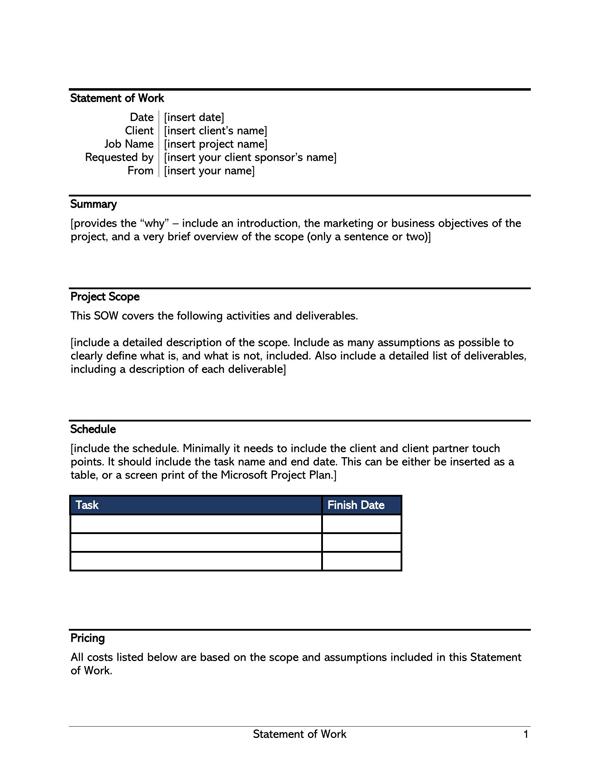
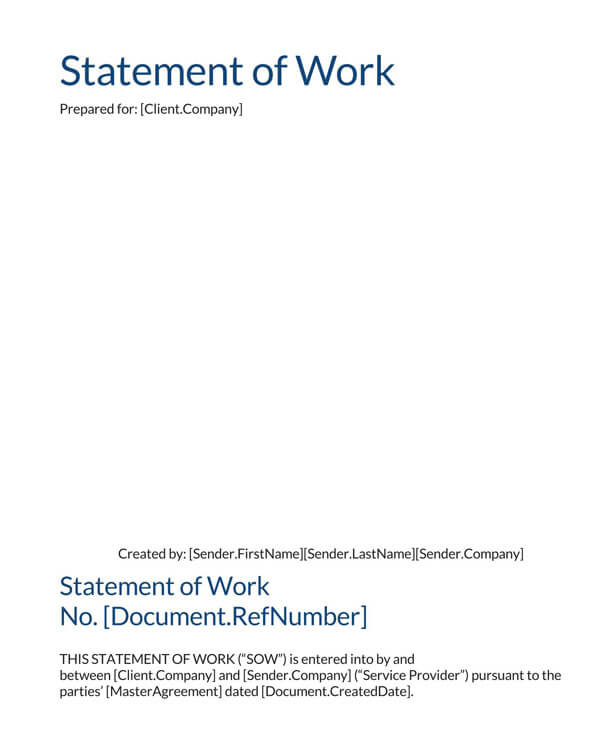
Types of SOW
There are different types of SOW. The following three types are the most common;
- Design/detail – A design SOW communicates how the supplier is expected to do the work.It also outlines the buyer’s requirements/expectations that control the processes of the supplier to meet these expectations. These expectations could be in terms of materials, measurements, tolerances, quality control requirements, etc. By declaring his or her expectations, the buyer consequentially bears the risk of performance since the supplier will follow the buyer’s guidelines.
- Level of effort – A level of effort SOW can be created for almost all types of services and projects. The primary deliverables outlined in this type of SOW are hours of work (time) and the materials required to complete the service, repair, development, etc.
- Performance-based – A performance-based SOW is used when the contract does not specify how the service is to be performed. Acquisitions made through a performance-based SOW are based on the purpose of the service or equipment to be supplied and not how the service is to be accomplished. Since the method of completion is not specified, the project manager has the freedom to select the best method of completion that delivers the expected results.
SOW Templates by Types
Provided below are SOW templates by different types:

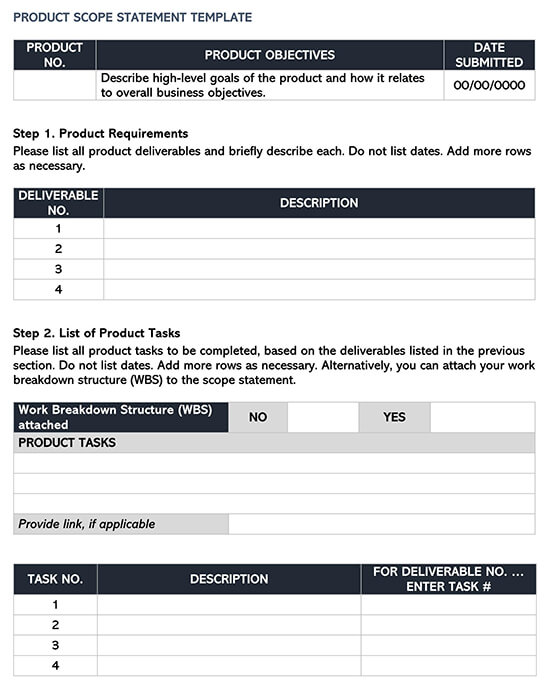
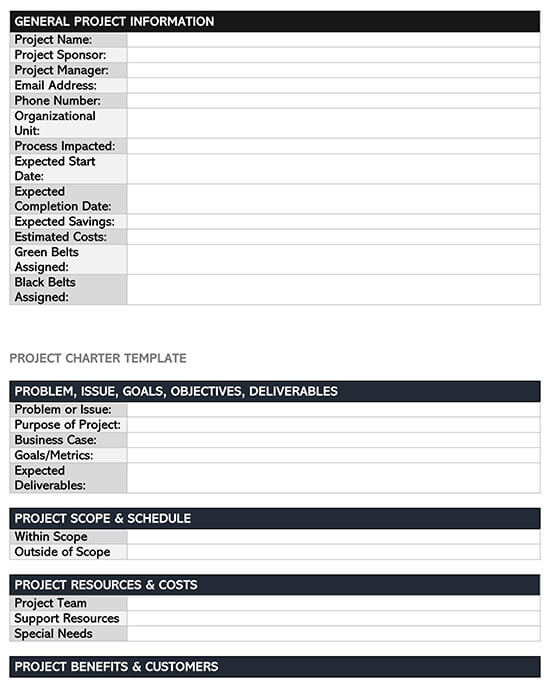
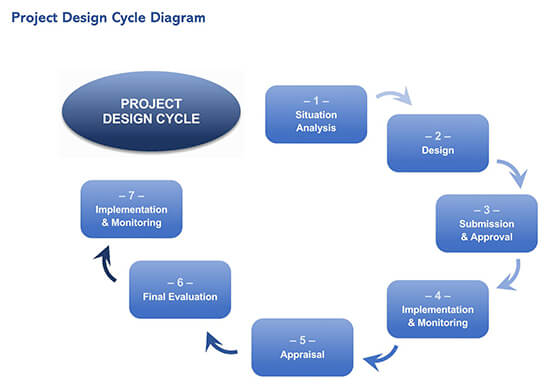
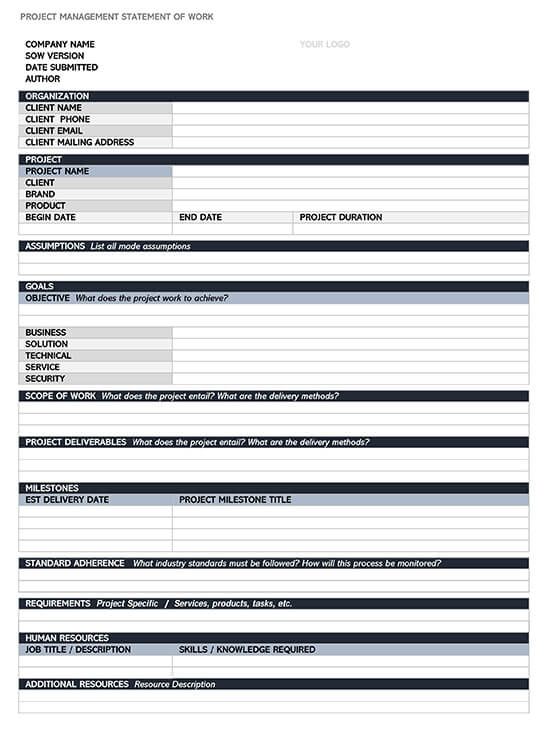
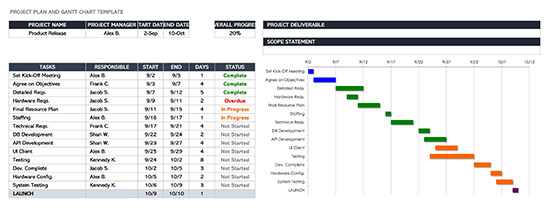
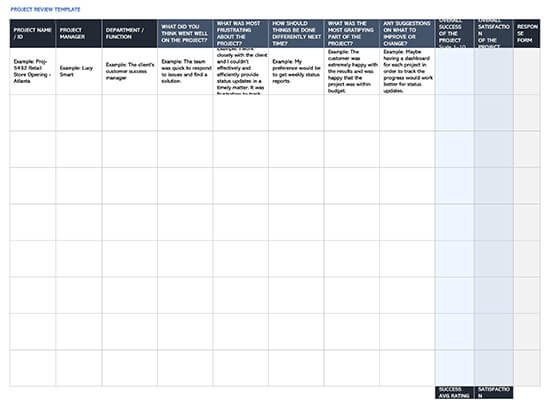
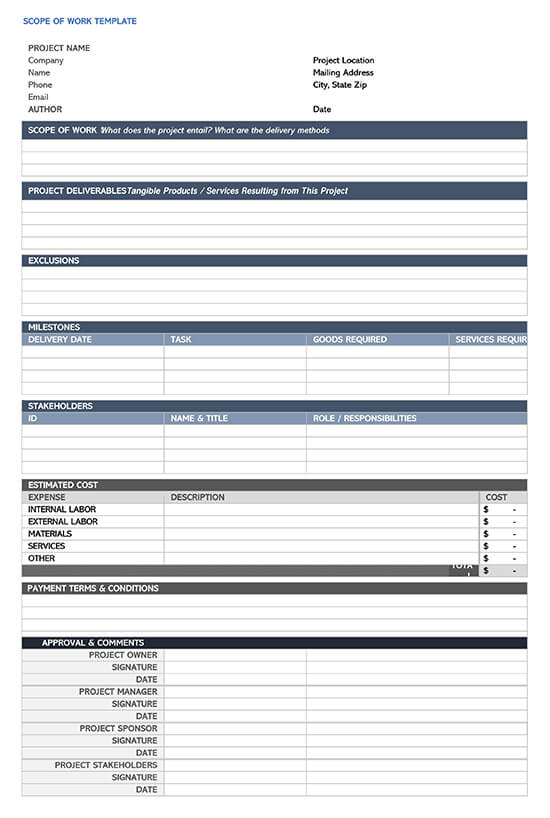
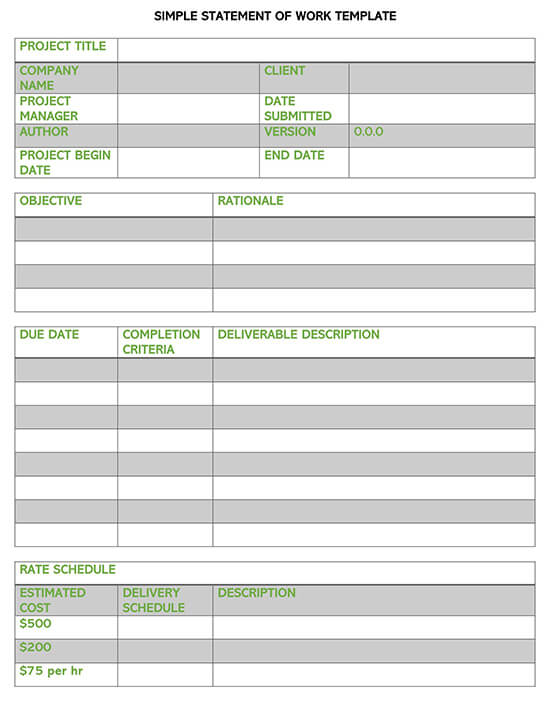
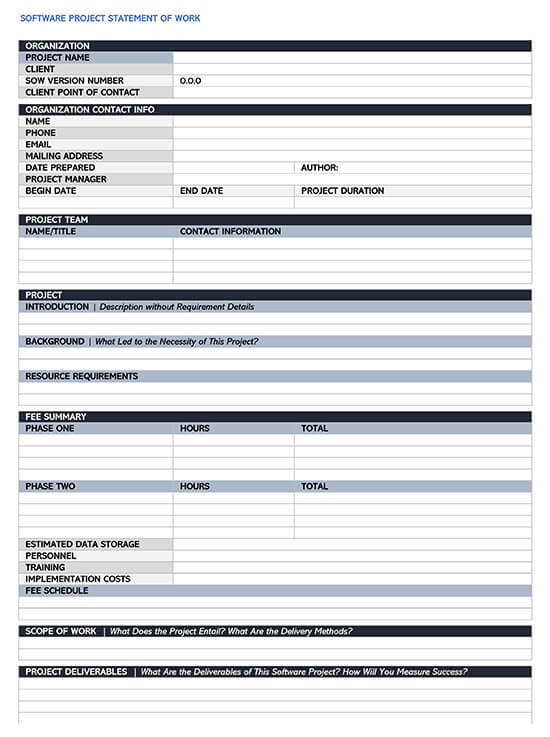
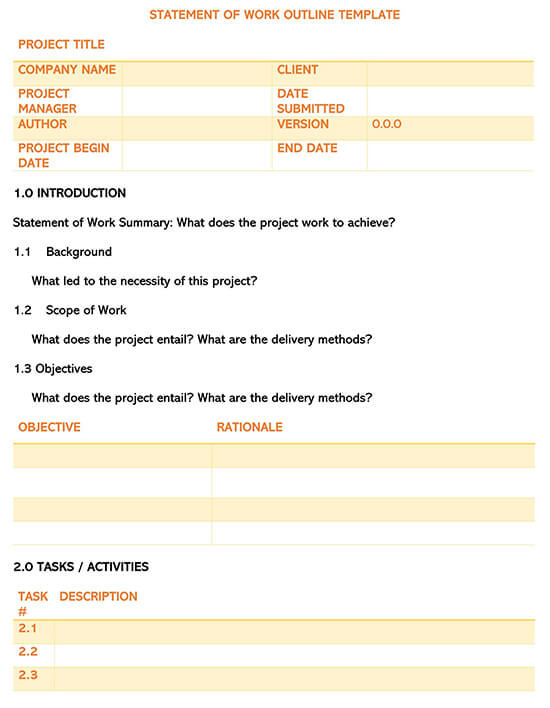
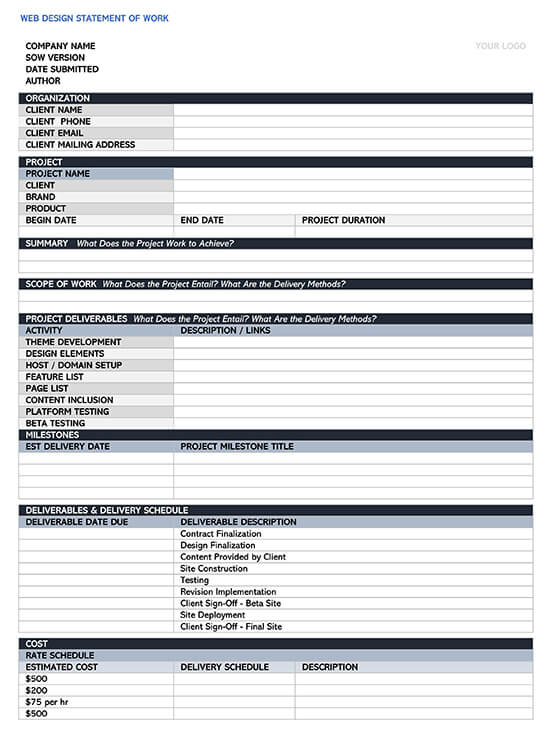
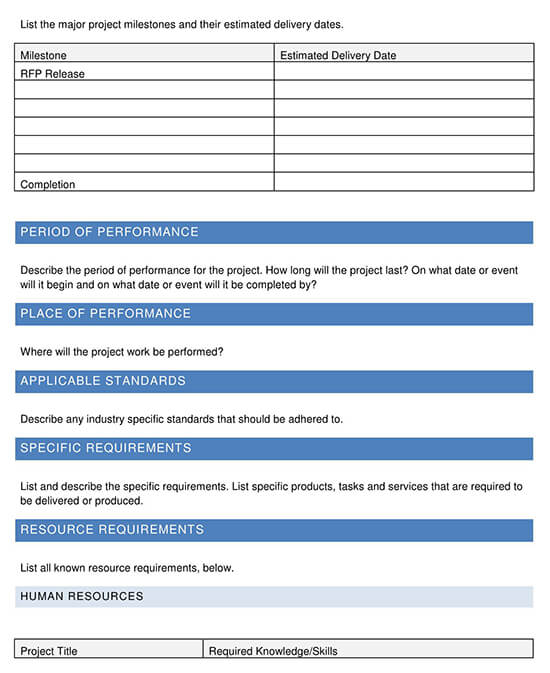
How does the Statement of Work be Helpful?
A statement of work template specifically helps you to understand the key sections of a SOW. There are various key sections that are very necessary in order to ensure you write a detailed one and you can only achieve this using a SOW template.Such template also helps you to know what to include in a SOW and the importance of such inclusion. It provides a sketch and all you need to do is just read through and fill the template to come up with a detailed SOW.
Using Statement of Work Template
Writing one from scratch can be taxing; therefore, using a template becomes important in simplifying the process. This article will discuss how one can use a SOW template to create an effective document that adequately serves the parties involved in the project.
The steps are as follows:
Use a checklist
Firstly, create a checklist that lists all the pertinent details that should go into the SOW template. There is commonly a lot of information that is required to effectively communicate through a SOW and having a checklist ensures an adequate plan is done so that no important information is forgotten.
Be flexible and anticipate changes
Secondly, anticipate changes to the checklist and the SOW. Even though most statements of work templates will have the basic components necessary for a majority of projects, it is good to obtain different types of SOW templates and select one that best fits the project at hand.
Create a change request form that can be used to incorporate changes once the SOW has been drafted. However, it is important to note changes deemed acceptable to stakeholders and the project beforehand and evaluate the costs associated in terms of time and money to implement the changes.
Make a list of stakeholders
Reporting is a major aspect of doing a project; identity who to update on the progress of the project down the line. Then create a list of stakeholders and all the authoritative figures involved in the project and indicate who is designated to make what decisions. As the project execution progresses, there will always be technicalities and legalities that need authorization, and it is, therefore, important to know who to approach in such cases.
Mention how to reach them
Lastly, indicate in the SOW template the procedures in place that communication can be achieved between stakeholders, project managers, and service providers. Then explicitly outline the necessary contents of SOW in the template, such as the scope of work, resources, deliverables, schedule, payments, etc.
Elements of an SOW Template
The specifics of an SOW will depend on the type and scope of the project. However, these specifics can be grouped in different categories that can be found in a SOW template.
Ordinarily, a SOW template will have the following elements:
- Introduction – An introduction gives an overview of what the project is, the parties involved, and their respective titles/positions.
- Governance – The SOW should have a section to name the party(ies) responsible for approving deliverables and bills.
- Background – The SOW should provide a brief summary of the project, for example, by highlighting the motivation behind the proposal of the project.
- Purpose – There should be a purpose statement in the SOW. The purpose statement should answer questions such as why the project was initiated and the mission of the team to be working on the project.
- Scope of work – A scope of work should appear in the SOW. The scope is meant to outline the general work that needs to be completed, the methods and processes that will be employed, and the timeframe within which the project should be completed.
- Location – There should be a section that provides information regarding the location where the project will be taking place. This becomes of great importance when the client and the service provider are in different regions because the distance will often influence the cost of services and goods.
- Deliverables – A list of all the deliverables should be provided in a clear and detailed manner. Deliverables represent the “finished product or service,” and the description should address the physical, visual, or whatever expectation of the finished product. Information that can be used to describe a deliverable is quantity, size, color, type of structure, etc.
- Schedule – There should be a time-based plan of events or activities that declares what activity is to be done (deliverables), the responsible party, and the expected completion date of each service. Scheduling should address the implementation phase, performance period, development phase, review phase, and the completion period – the project life cycle.
- Milestones – A milestone is a major event during the developmental phase of the project. The SOW should indicate important deadlines that are to be met, which can be used to measure progress. Milestones are an effective way of dividing the project into measurable and achievable phases.
- Tasks – Tasks are meant to break down the scope of work into simpler and specific tasks whose completion contributes to a major activity or event. Basically, tasks are clear-cut activities accomplished in order to achieve milestones and the steps outlined in the scope of work.
- Reporting and communication plan – The SOW ought to outline a system or procedure for reporting progress, concerns, and misunderstandings. The provided system of reporting and communication must be effective between stakeholders of the project.
- Standards and testing – Quality control is vital in projects. There are usually standards that the project is expected to comply with. The SOW should state the procedures and testing to be followed if these standards are to be adhered to.
- Define success – There should be a clear definition of what the client or stakeholders expect from the project. The metric that will be used to measure the successful completion of the project. Success is normally defined by the expected outcome.
- Special terms, conditions, and requirements – Additional terms that don’t fit in the already provided categories should be included as requirements in the SOW. This includes certifications, educational qualifications, and special equipment or resources needed.
- Payments – The SOW should declare the costs of the services to be delivered as per the project budget – the payment amount. The terms of payment should also be indicated, for example, the payment schedule – will it be up-front or upon completion, and will payment be per milestone. Involved parties should agree on the payment plan.
- Assumptions – Any variables associated with the project should be outlined in the SOW. Assumptions will normally limit either party’s liability.
- Others – Aspects that do not fall under any of the categories provided in the SOW template should be written down under the “other” section. Due to the uniqueness of every project, there will always be auxiliary or support items specific to the project. This includes travel compensation, post-project support, protection of proprietary information, and such.
- Closure – The last section of the template is meant to address how the named deliverables will be accepted. Details such as who will deliver, review and sign off (approve) on the deliverables should appear on the SOW.
Conclusion
An SOW is an extensive document that is important in keeping track of the progress of a project and ensuring that milestones are achieved within budget limits and on time. The fundamental components of a SOW template are the project definition, the scope of work, timeline of the project, deliverables, activities to be completed, expectations in terms of standards, and payments/resources.








